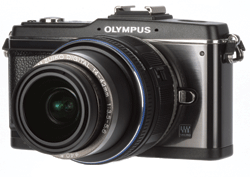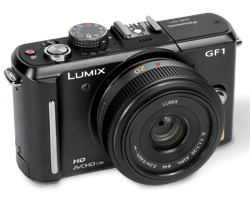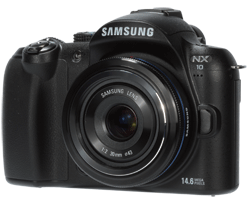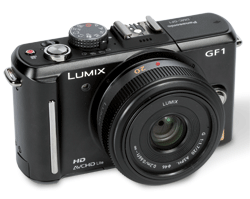In our article: What are Micro System cameras, we explain what micro four thirds cameras are and give overviews of the micro system cameras on the market today.
Combining the interchangeable-lens benefits of DSLRs with the size and portability of compacts
Micro System cameras – often referred to as ‘Hybrids‘ – are a relatively new breed of digital camera that straddle the gap between advanced-level compacts and fully-fledged DSLRs. All Micro System cameras (bar the Samsung NX10) are based on the Micro Four Thirds format jointly developed by Olympus and Panasonic and use the same 17.3 x 13mm sensor found in regular Four Thirds DSLRs. They also benefit from the same interchangeable lens system offered by their full-sized DSLR cousins.
The reason Micro System cameras are not classed as DSLRs is because they lack the pentaprism mirror system that gives DSLR users a through-the-lens view of their subject when composing a shot. Instead, Micro System cameras use either the rear LCD screen as on a regular compact, or an electronic viewfinder system that relays information from the sensor. For this reason it’s worth paying close attention to the quality of the rear LCD screen.
The main benefit of Micro System cameras over DSLRs is that they are smaller and lighter, making them ideal as a travel camera. And because they house a significantly larger sensor than most compacts, image quality is far above that of a point-and-shoot. In many ways they really do offer the best of both worlds.
Panasonic Lumix G1
Price: £450 with 14-42mm kit lens
Our rating: 85%
Sensor: 12MP
Shooting modes: PASM, iAuto, Scene
ISO
Range: 100-3200
HD Video: No
Image Stabilisation:
Lens based
LCD: 3in, 460k-dot
Size: 124 x 83.6 x
45.2mm
Weight: 385g
Launched at the tail-end of 2008, the G1 was the first Micro Four Thirds model to reach the shops. It’s recently been replaced by the G2 (see below left), but remains readily available. Lacking video recording, the G1 nonetheless remains a highly competent camera. Of particular note is the articulated rear LCD that pulls away from the body and rotates through 270°. Images can also be composed through an electronic viewfinder (EVF). While EVFs are generally perceived as something of a weak link due to their flickery nature and low-resolution, the 1.4million-pixel EVF in the G1 goes some way to correcting this with a bright and detailed picture. Image quality of the G1 is good, though our testers noted that there is a tendency for images to lack a bit of punch – something that can easily be corrected in post-production. Being an older model, it is now available at far less than its original RRP. Looking for a bargain?
Read review of the Panasonic Lumix G1
Olympus E-PL1
Price: £500 with 14-42mm kit lens
Our rating: 88%
Sensor: 12.3MP
Shooting modes: PASM, iAuto, Scene
ISO
Range: 100-3200
HD Video: Yes
Image Stabilisation:
In-camera
LCD: 2.7in, 230k-dot
Size: 114.6 x 83.6 x
45.2mm
Weight: 385g
Designed with novice users in mind, the E-PL1 debuts a new Live Guide interface that, as the name suggests, guides the user through the use of certain shooting parameters in an easy-to-understand way, offering recommendations for certain types of subject. Despite being the entry-point into Olympus’s stylish PEN range, the E-PL1 is its only model so far to offer an inbuilt flash along with a dedicated button to start and stop HD movie recording with. The fixed rear LCD measures 2.7 inches and offers a resolution of 230k-dots – a bit low for its class. In keeping with its fun persona, the camera also sports a number of Art Filters that allow the user to add a touch of ‘Gentle Sepia’ or ‘Pop Art’ to their images in-camera. Image quality is of a generally high standard with impressive detail. Noise is well controlled, although visible in some shadow detail even at lower ISO settings. Overall, it’s a fine example of what the Micro System genre can offer.
See review of the Olympus E-PL1
Samsung NX-10
Price: £500 with 18-55mm kit lens
Our rating: 88%
Sensor: 14.6MP
Shooting modes:
PASM, Scene
ISO Range: 100-3200
HD Video: Yes, 720p
at 25fps
Image Stabilisation: Lens based
LCD: 3in,
614k-dot AMOLED
Size: 123 x 87 x 39.8mm
Weight: 353g
While Panasonic and Olympus have been rolling out Micro Four Thirds models for the best part of 18 months now, they are not the only players in the Micro System market. Samsung’s NX10 approaches things from its own unique angle by employing a 14.6MP APS-C sized CMOS sensor that’s considerably larger than those found in Olympus and Panasonic models. There’s also a class-leading 3in, 614k-dot AMOLED screen that doesn’t require backlighting, making it less battery hungry, along with a 921k-dot EVF that allows you to hold the NX10 to your eye as you would a regular DSLR. HD movie recording is catered for, as is the ability to shoot in either Raw or JPEG. Alongside Samsung’s expanding range of dedicated NX lenses, NX10 owners can also use DSLR lenses from Samsung and Pentax via an optional K-mount adaptor, although this
will require manual focus to be used.
See review of the Samsung NX-10
Panasonic Lumix GF1
Price: £590 with 14-42mm kit lens
Our rating: 89%
Sensor: 12MP
Shooting modes: PASM, iAuto, Scene
ISO
Range: 100-3200
HD Video: Yes
Image Stabilisation:
Lens based
LCD: 3in, 460k-dot
Size: 119 x 71 x
36.3mm
Weight: 285g
Released in 2009, the GF1 takes the MFT theme of compactness and makes it even smaller – pair it with a 20mm ‘pancake’ lens and it’s small enough to fit in a jacket pocket. Not that this compromises its feature-set in any way, though. Rather, the GF1 packs a range of useful and advanced features that includes HD video capture, subject tracking AF mode and peripheral defocusing. While enthusiast and advanced photographers are catered for with the full range of PASM shooting modes, for the novice there’s also the safety-net setting of iAuto, whereby the camera will work out everything on your behalf just like a regular point-and-shoot – with generally pleasing results. As for lens options, an optional conversion mount allows standard Four Thirds DSLR lenses from Panasonic and Olympus to be used. There’s even a conversion mount for Leica lenses, should you have them.
See review of the Panasonic Lumix GF1
 Olympus E-P2
Olympus E-P2
Price: £800 with 14-42mm kit lens
Our rating: 88%
Sensor: 12.3MP
Shooting modes:
PASM, iAuto, Art, Scene
ISO Range: 100-6400
HD Video:
Yes
Image Stabilisation: Built-in
LCD: 3in,
230k-dot
Size: 121 x 70 x 36mm
Weight: 335g
Like the E-P1 that preceded it, the E-P2 takes its style cues from the classic 1950s Olympus PEN film camera. Underneath all that retro chic though, lies a thoroughly 21st-century camera. With in-camera image stabilisation freeing up your choice of lens, the E-P2 also benefits from a set of dedicated Art Filters, the option to capture images as either Raw or compressed JPEG files, and the ability to record 720p HD movies at 30fps. While there’s no inbuilt flash, it is possible to attach one via the E-P2’s hotshoe. This same hotshoe can also be used to attach an optional Olympus VF-2 electronic viewfinder – though obviously not at the same time as a flash. Image quality is of a good standard, though white balance often leans towards the warmer end of the scale. Noise is well controlled at lower ISO settings, although by the top setting of ISO 6400, images lose a lot of detail.
See review of the Olympus E-P2









